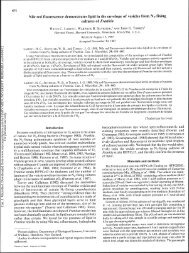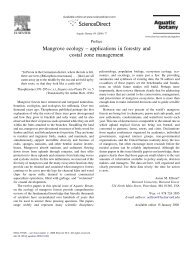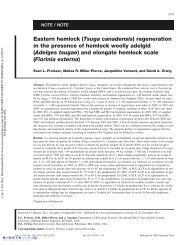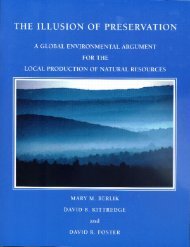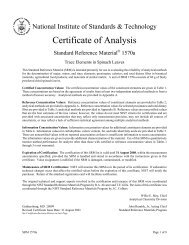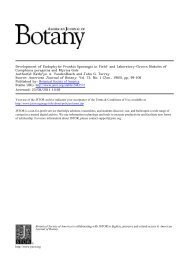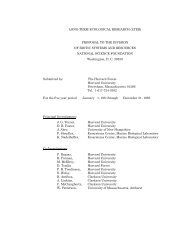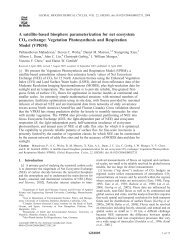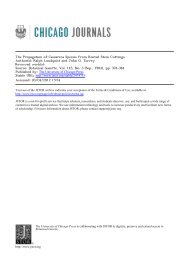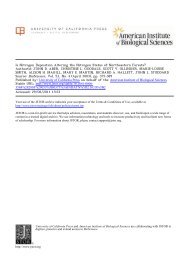Abstracts of Papers - Harvard Forest - Harvard University
Abstracts of Papers - Harvard Forest - Harvard University
Abstracts of Papers - Harvard Forest - Harvard University
You also want an ePaper? Increase the reach of your titles
YUMPU automatically turns print PDFs into web optimized ePapers that Google loves.
Certainly, no single hormone-based model can be<br />
presented at present to account for sexual different-<br />
iation. Studies <strong>of</strong> protein patterns and other gene-<br />
product analyses are rare and at present<br />
inconcl usive.<br />
HALEVY, ABRAHAM H. Department <strong>of</strong> Environmental<br />
Horticulture, The <strong>University</strong> <strong>of</strong> California, Davis.<br />
(on leave from The Hebrew <strong>University</strong>, Rehovot,<br />
Israel).<br />
- Regulation <strong>of</strong> petal senescence.<br />
The main growth regulator controlling petal senescence<br />
<strong>of</strong> some flowers (e.g., carnations) is ethylene.<br />
Other flowers (e.g., roses) are much less sensitive<br />
to ethylene. The most effective inhibitor <strong>of</strong> senescence<br />
and abscission in ethylene-sensitive flowers is<br />
Ag+, applied as Ag-thiosulfate. Cytokinins delay<br />
petal senescence by inhibiting ethylene biosynthesis.<br />
Pollination promotes petal senescence. There seems<br />
to be a multi-stage pollination-induced senescence<br />
signal. The first one being I-aminocyclopropane-lcarboxylic<br />
acid (ACC), diffused from the pollen.<br />
Wound-ethylene and auxin may participate in later<br />
stages. In both ethylene sensitive and ethylene nonsensitive<br />
flowers, a decrease in membrane fluidity<br />
was observed during aging. Environmental or chemical<br />
agents modifying the rate <strong>of</strong> senescence, correspondingly<br />
also altered the rate <strong>of</strong> change in petal membranes<br />
fluidity. The decrease in fluidity corresponding<br />
to an increase in the ratio <strong>of</strong> free sterols<br />
to phospholipids, due to a decrease in the content<br />
<strong>of</strong> membrane phospholipids. The activity <strong>of</strong> petal<br />
ATPase and <strong>of</strong> sucrose uptake by the petals is correlated<br />
with membrane fluidity. These processes may<br />
regulate the reduction in water and dry weight<br />
content <strong>of</strong> fading petals.<br />
KEVAN, PETER G. Department <strong>of</strong> Environmental<br />
Biology, <strong>University</strong> <strong>of</strong> Guelph, Guelph, Ontario<br />
NlG 2W1, Canada.<br />
- Floral characteristics for pollinators.<br />
Floral attractants appeal to the senses <strong>of</strong> pollina-<br />
tors and should be investigated with those in mind.<br />
Attractants may be visual, as colors, color patterns,<br />
sizes, outline shapes, and arrangement <strong>of</strong> floral<br />
parts. Depth effects, as in tube- and funnel-shaped<br />
flowers are also involved. Olfactory cues function<br />
in long- and short-distance attraction <strong>of</strong>, and in<br />
flower discrimination by pollinators. Guide patterns<br />
on flowers may be visual, chemical, and structural<br />
and aid pollinators in foraging and pollinating. Mi-<br />
crosculptural features on flowers are distinguished<br />
by insects which may use them as guides and in plant<br />
species recognition. Some floral structures benefit<br />
pollinators by providing shelter and/or warmth.<br />
Color, form, presentation, and sporophyll placement<br />
indicate the various pollination syndromes. Correla-<br />
ted with those are features <strong>of</strong> pollen and the<br />
chemical nature and amounts <strong>of</strong> floral rewards for<br />
pollinators.<br />
KONING, ROSS E. Department <strong>of</strong> Biological Sciences-<br />
Botany, Rutgers <strong>University</strong>, Piscataway, NJ 08854.<br />
- Plant hormones and growth <strong>of</strong> flower parts during<br />
flFoweropening.<br />
There is no simple understanding <strong>of</strong> the roles <strong>of</strong> plant<br />
hormones in control <strong>of</strong> flower part growth since, until<br />
recently, no species had been examined for the<br />
Developmental and Structural Section 11<br />
roles <strong>of</strong> all <strong>of</strong> the plant hormones, both applied and<br />
endogenous, in growth <strong>of</strong> all <strong>of</strong> the flower parts.<br />
Such an analysis was recently completed for Gaillardia<br />
gra randiflora. Three types <strong>of</strong> measurements weiMade:<br />
1) growth <strong>of</strong> the flower parts under natural conditions,<br />
2) growth <strong>of</strong> isolated flower parts in response<br />
to hormones applied in vitro, and 3) the endogenous<br />
hormone levels. These measurements were correlated<br />
with each other to determine the roles <strong>of</strong> the<br />
various plant growth substances. In Gaillardia,<br />
corolla elongation occurs by gibberelliT <strong>of</strong>rel, ffilament<br />
and style elongation occur by auxin control, and<br />
stigma unfolding occurs by ethylene control. The ray<br />
flower corolla must be fully expanded to attract pollinators<br />
before the fertile disc flowers open, thus<br />
explaining need for separate controls. The growth <strong>of</strong><br />
the filaments and the style can be controlled by a<br />
single hormone; the sequential events are timed by<br />
the position <strong>of</strong> the two organs with respect to the<br />
auxin source: the pollen. As pollen develops, auxin<br />
is first transported to the filament; only after the<br />
pollen is shed directly onto the stigma, is the auxin<br />
transported to the style. The level <strong>of</strong> auxin in the<br />
stigma is then high enough to promote the production<br />
<strong>of</strong> ethylene and cause stigma unfolding. The tidy<br />
control mechanism elucidated in Gaillardia probably<br />
applies only to members <strong>of</strong> a sma <strong>of</strong> Asteraceae<br />
species, since in the literature, unrelated<br />
plants have different methods <strong>of</strong> developmental control.<br />
Future complete studies will provide a basis<br />
for sorting the seemingly contradictory findings into<br />
a more systematic understanding <strong>of</strong> flower part growth.<br />
LANG, ANTON. MSU-DOE<br />
Plant Research Laboratory,<br />
Michigan State <strong>University</strong>, East Lansing, MI 48824<br />
- Flower induction: endogenous hormone-like<br />
factors .<br />
Evidence for a hormone-like inducer <strong>of</strong> flower forma-<br />
tion ("florigen"), which is formed in the leaves<br />
while acting in the apical shoot meristems, exists<br />
for about 50 years. Most <strong>of</strong> it is based on grafting<br />
experiments between photoperiodic plants maintained<br />
in the noninductive daylength ("receptors") on one<br />
hand and similar plants exposed to the inductive day-<br />
length or dayneutral (DN) plants ("donors") on the<br />
other. Experiments <strong>of</strong> this kind have been done in<br />
eight plant families. It has al so been shown that<br />
long-day (LD) receptors can be induced to form<br />
flowers by LD, short-day (SD) and DN donors; SD re-<br />
ceptors can be induced by SD, LD and DN donors; and<br />
flower in DN receptors can be hastened by LD and SD<br />
donors. Donors and receptors can belong to the same<br />
species, to different species <strong>of</strong> the same genus, and<br />
to different genera. Thus, florigen appears to be<br />
ubiquitous and to be nonspecific in both the taxono-<br />
mic sense and with respect to the physiological re-<br />
sponse type. For about 5 years we also have evidence<br />
for a graft-transmissible inhibitor <strong>of</strong> flower forma-<br />
tion ("antiflorigen"), so far in two LD plants.<br />
Antiflorigen inhibits flower induction in DN and SD<br />
plants <strong>of</strong> the same or a different genus; like flori-<br />
gen it is evidently nonspecific both taxonomically<br />
and physiologically. Flower induction thus appears<br />
to involve both promotive and inhibitory, endogenous<br />
hormone-like factors: florigen which in LD and SD is<br />
formed only in LD and SD respectively, while in DN<br />
plants it is formed independent <strong>of</strong> daylength; and<br />
antiflorigen which is formed at least in some LD<br />
plants under SD conditions. This situation will be<br />
briefly discussed in relation to other aspects <strong>of</strong><br />
f lower i nd ucti on .




